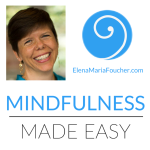 (meditation: 10:47 min) This meditation is a combination of two practices. It starts with Field of Vision and then shifts to Sensational Awareness.
(meditation: 10:47 min) This meditation is a combination of two practices. It starts with Field of Vision and then shifts to Sensational Awareness.
This meditation is great for people who prefer eyes open practices and who also want to work with pain or discomfort in their bodies.
Instructions:
- Begin by getting into position, whatever position works best for your body. This position will become your body-mind’s signal that you are starting a practice. I suggest the following:
- Sit on a chair (sofa, bed, etc) with your feet flat on the floor. Rest your hands in your lap. Feel your sit bones pressing down. Float the crown of your head up so that it softly lifts your torso into alignment. Let your back body be a bit firm to maintain this posture and your front body be soft and relaxed.
- Close your eyes and bring your attention to your breath. Notice how it feels to breathe for a few breaths.
- Then, soften your eyelids and open your eyes. Look down, comfortable distance in front of you at the floor or desk/table if you are sitting at your desk/table.
- Let your physical eyes be soft, relaxing the muscles around the eyes. Your vision may get blurry at some point, and let that happen.
- Notice what you can see in front of you and also widen your attention to notice your whole field of vision. With out moving your eyes or head, take in your peripheral vision.
- Let thoughts float through the background like passing clouds.
- If you find that your attention has become absorbed in your thoughts and you’re no longer noticing what you’re looking at, gently bring your attention back to what you can see.
- After a few minutes, shift your attention to your breath for a few breaths, and then into body. Find an area of the body that is stiff, sore or painful.
- Bring your attention to this part, honoring it with your attention. You are not trying to make it go away, instead you are noticing it in all of it’s uncomfortable glory. It is there for a reason, and we’re honoring the wisdom of our body – the signals that it is giving us.
- Notice the qualities of the area, how big it is (where are the edges?), how dense? how sharp/dull, what texture? if you could see it what color would it be? etc.
- When you feel ready or when your timer rings, end the practice by bringing your attention back to your breath for a few breaths and then gently opening your eyes.
To Download:
Click on the Download button below.
If it does not download automatically:
- A new window will open with an audio player (like the player above).
- Right click on the player and choose “Download File” or “Download Video”
- iPhone users will want to first copy the meditation into iTunes (on your computer) and then sync with your iPhone.
Note that you are welcome to download and share this files as many times as you like provided you do so in it’s entirety and it is used for personal or educational use only (no commercial uses).

